I have a spring batch application that uses Azure SQL server as a backend, I am using Hibernate to update the database.
I am reading the data from CSV file using FlatfileReader & writing into Azure SQL Server using ItemWriter as mentioned below
Below is my Hibernate configuration
<beans
xmlns="http://www.springframework.org/schema/beans"
xmlns:xsi="http://www.w3.org/2001/XMLSchema-instance"
xmlns:batch="http://www.springframework.org/schema/batch"
xmlns:context="http://www.springframework.org/schema/context"
xmlns:tx="http://www.springframework.org/schema/tx"
xmlns:p="http://www.springframework.org/schema/p"
xsi:schemaLocation="http://www.springframework.org/schema/batch
http://www.springframework.org/schema/batch/spring-batch-2.2.xsd
http://www.springframework.org/schema/beans
http://www.springframework.org/schema/beans/spring-beans-3.2.xsd
http://www.springframework.org/schema/tx
http://www.springframework.org/schema/tx/spring-tx.xsd
http://www.springframework.org/schema/context
http://www.springframework.org/schema/context/spring-context-3.0.xsd
">
<context:annotation-config/>
<context:component-scan base-package="com.demo.entity" />
<bean id="itemWriter" class="com.demo.batch.jobs.csv.Writer" >
<constructor-arg ref = "hibernateItemWriter"/>
</bean>
<bean id="hibernateItemWriter" class="org.springframework.batch.item.database.HibernateItemWriter">
<property name="sessionFactory" ref="sessionFactory"/>
</bean>
<bean id="sessionFactory" class="org.springframework.orm.hibernate5.LocalSessionFactoryBean" >
<property name="dataSource" ref="irusDataSource"/>
<property name="hibernateProperties" ref="hibernateProperties"/>
<property name="packagesToScan">
<list>
<value>com.demo.*</value>
</list>
</property>
</bean>
<!-- DATA SOURCE -->
<bean id="irusDataSource" class="org.springframework.jdbc.datasource.DriverManagerDataSource">
<property name="driverClassName" value="com.microsoft.sqlserver.jdbc.SQLServerDriver" />
<property name="url" value="jdbc:sqlserver://sqlserver85.database.windows.net:1433;database=sqldb;encrypt=true;trustServerCertificate=false;hostNameInCertificate=*.database.windows.net;loginTimeout=30;" />
<property name="username" value="ddddd" />
<property name="password" value="`JNp" />
</bean>
<bean id="transactionManager" class="org.springframework.orm.hibernate5.HibernateTransactionManager" lazy-init="true">
<property name="sessionFactory" ref="sessionFactory" />
</bean>
<tx:annotation-driven transaction-manager="transactionManager"/>
<bean id="hibernateProperties" class="org.springframework.beans.factory.config.PropertiesFactoryBean">
<property name="properties">
<props>
<prop key="hibernate.dialect">org.hibernate.dialect.SQLServer2012Dialect</prop>
</props>
</property>
</bean>
</beans>
<bean id="cvsFileItemReader" class="org.springframework.batch.item.file.FlatFileItemReader">
<property name="resource" value="classpath:cvs/input/students.csv" />
<property name="lineMapper">
<bean class="org.springframework.batch.item.file.mapping.DefaultLineMapper">
<property name="lineTokenizer">
<bean
class="org.springframework.batch.item.file.transform.DelimitedLineTokenizer">
<property name="names" value="student" />
</bean>
</property>
<property name="fieldSetMapper">
<bean class="com.demo.batch.mapper.StudentMapper" />
</property>
</bean>
</property>
</bean>
<batch:step id="starterJob">
<batch:tasklet>
<batch:chunk
reader="cvsFileItemReader"
processor="itemProcessor"
writer="itemWriter"
commit-interval="100">
</batch:chunk>
</batch:tasklet>
</batch:step>
Below is the ItemProcessor
import com.demo.entity.Student;
import org.springframework.batch.item.ItemProcessor;
public class Processor implements ItemProcessor<Student, Student> {
@Override
public Student process(Student item) throws Exception {
System.out.println("Processing..." + item);
//Thread.sleep(50);
return item;
}
}
Below is the ItemWriter
public class Writer implements ItemWriter<Student> {
private HibernateItemWriter<Student> hibernateItemWriter;
public Writer(HibernateItemWriter<Student> hibernateItemWriter) {
this.hibernateItemWriter = hibernateItemWriter;
System.out.println("Hibernate Writer instance is created..: " + hibernateItemWriter.hashCode());
}
@Override
//@Transactional(propagation = Propagation.REQUIRES_NEW)
public void write(List<? extends Student> list) throws Exception {
hibernateItemWriter.write(list);
}
}
The CSV file has 6k records, at times it takes 4mins to complete the job
How could the simple code executed on the same VM will have different performance results? Is this something due to Azure SQL Performance being inconsistent? How to ensure that it will always have 4mins execution time?
Stats for 4mins execution
19100 nanoseconds spent acquiring 1 JDBC connections;
0 nanoseconds spent releasing 0 JDBC connections;
15127700 nanoseconds spent preparing 200 JDBC statements;
4103544900 nanoseconds spent executing 200 JDBC statements;
0 nanoseconds spent executing 0 JDBC batches;
0 nanoseconds spent performing 0 L2C puts;
0 nanoseconds spent performing 0 L2C hits;
0 nanoseconds spent performing 0 L2C misses;
2099567900 nanoseconds spent executing 1 flushes (flushing a total of 100 entities and 0 collections);
Stats for 15mins execution
19400 nanoseconds spent acquiring 1 JDBC connections;
0 nanoseconds spent releasing 0 JDBC connections;
15668300 nanoseconds spent preparing 200 JDBC statements;
13671456600 nanoseconds spent executing 200 JDBC statements;
0 nanoseconds spent executing 0 JDBC batches;
0 nanoseconds spent performing 0 L2C puts;
0 nanoseconds spent performing 0 L2C hits;
0 nanoseconds spent performing 0 L2C misses;
6881730800 nanoseconds spent executing 1 flushes (flushing a total of 100 entities and 0 collections);

